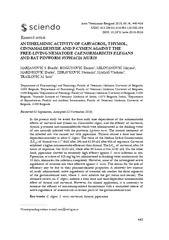Приказ основних података о документу
Antihelminic activity of carvacrol, thymol, cinnamaldehyde and p-cymen against the free-living nematode caenorhabditis elegans and rat pinworm syphacia muris
| dc.creator | Marjanović, Đorđe | |
| dc.creator | Bogunović, Danica | |
| dc.creator | Milovanović, Mirjana | |
| dc.creator | Marinković, Darko | |
| dc.creator | Zdravković, Nemanja | |
| dc.creator | Magaš, Vladimir | |
| dc.creator | Trailović, Saša | |
| dc.date.accessioned | 2020-06-03T14:24:38Z | |
| dc.date.available | 2020-06-03T14:24:38Z | |
| dc.date.issued | 2018 | |
| dc.identifier.issn | 0567-8315 | |
| dc.identifier.uri | https://vet-erinar.vet.bg.ac.rs/handle/123456789/1615 | |
| dc.description.abstract | In the present study we tested the dose andh time dependence of the antinematodal effects of carvacrol and tyhmol on Caenorabditis elegans, and the efficacy of carvacrol, thymol, p-cymene and cinnamaldehyde,which were administrated in the drinking water of rats naturally infected with the pinworm Syphada muris. The control treatment of the infected rats was carried out with piperazine. Thymol caused a dose and time-dependent mortality in adult C. elegans. The value of the Median Lethal Concentration (LC50) of thymol was 117.9nM after 24h and 62.89 nM after 48h of exposure. Carvacrol exhibited a higher antinematodal efficiency than thymol. The LC50 of carvacrol, after 24 hours of exposure, was 53.03 nM, while after 48 hours it was 33.83 nM. On the other hand, piperazine showed an extremely high efficacy against S. muris infection in rats. Piperazine, at a dose of 625 mg/kg bw, administered in drinking water continuously for 10 days, eliminates the infection completely. However, none of the investigated active ingredients of essential oils were effective against S. muris. The reason for the lack of efficiency may be due to their pharmacokinetic properties. A relatively low amount of, orally administered, active ingredients of essential oils reaches the distal segments of the gastrointestinal tract, where S. muris inhabits the gut (colon and cecum). The obtained results, on C. elegans, indicate a clear dose and time-dependent antinematodal effect of thymol and carvacrol. However, for clinical application, it is necessary to examine the efficacy of microencapsulated formulations with a controlled release of active ingredients of essential oils in certain parts of the gastrointestinal tract. | en |
| dc.publisher | Univerzitet u Beogradu - Fakultet veterinarske medicine, Beograd | |
| dc.relation | info:eu-repo/grantAgreement/MESTD/Technological Development (TD or TR)/31087/RS// | |
| dc.rights | openAccess | |
| dc.source | Acta Veterinaria-Beograd | |
| dc.subject | C. elegans | en |
| dc.subject | S. muris | en |
| dc.subject | carvacrol | en |
| dc.subject | thymol | en |
| dc.subject | piperazine | en |
| dc.title | Antihelminic activity of carvacrol, thymol, cinnamaldehyde and p-cymen against the free-living nematode caenorhabditis elegans and rat pinworm syphacia muris | en |
| dc.type | article | |
| dc.rights.license | ARR | |
| dcterms.abstract | Маринковић, Дарко; Марјановић, Ђорђе; Здравковић, Немања; Миловановић, Мирјана; Богуновић, Даница; Магаш, Владимир; Траиловић, Саша; | |
| dc.citation.volume | 68 | |
| dc.citation.issue | 4 | |
| dc.citation.spage | 445 | |
| dc.citation.epage | 456 | |
| dc.citation.other | 68(4): 445-456 | |
| dc.citation.rank | M23 | |
| dc.identifier.wos | 000456859500006 | |
| dc.identifier.doi | 10.2478/acve-2018-0036 | |
| dc.identifier.scopus | 2-s2.0-85060916123 | |
| dc.identifier.fulltext | https://vet-erinar.vet.bg.ac.rs/bitstream/id/576/1614.pdf | |
| dc.type.version | publishedVersion |

